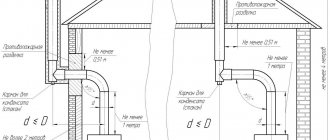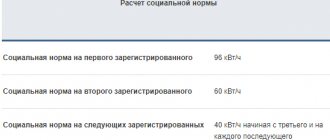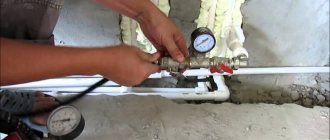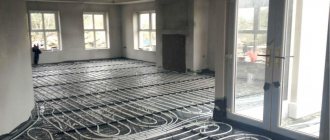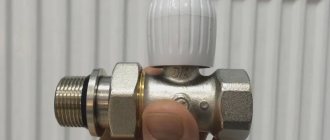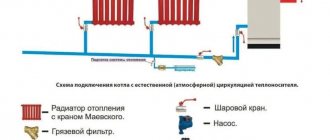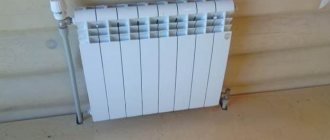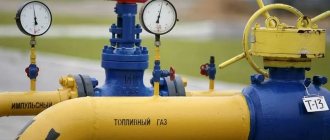Apartment-by-apartment and general-house standards for utility consumption
Let's look at what the thermal energy consumption standard is and how it is calculated. The procedure for calculating and setting heating standards is regulated by Government Decree No. 306. General provisions and formulas for calculating heat supply, taking into account the presence or absence of metering devices, are established by Government Decree No. 354.
According to clause 10 of PP No. 306, standards are established in relation to individual consumption of utilities and maintenance of the common property of an apartment building. Owners who have not installed meters pay for heating according to standards that involve calculating the average rate of heat energy consumption.
The calculation formula takes into account the following features:
- the presence of a common house meter (read more about heat meters for heating here);
- number of installed individual metering devices;
- billing period: 12 calendar months or according to the heating season schedule.
The standards are established by regional regulations and, as of 2022, apply to apartment buildings that do not have individual or communal meters installed. If a house has a communal meter installed, but no individual meters are installed, then the calculation is made in accordance with its indicators. Owners with private ownership pay for heating according to individual requirements.
Important! Based on PP No. 603, increasing coefficients are not applied to consumers who have not installed IPU in residential premises when calculating heating fees.
There are also separate rules that regulate the commercial metering of thermal energy and coolant. This document describes in detail the requirements for individual investment management, accounting methods, and much more.
Who installs them?
Based on clause 9 of PP No. 306, average standards for thermal energy consumption per 1 sq. m has the right to establish:
- regional executive authorities;
- resource supply organizations;
- management companies;
- housing cooperatives;
- partnership.
The establishment of standards at the initiative of the management company or resource supplying organization is carried out on the basis of a collective application to the authorized body and is considered within 30 days.
What kind of compensation can you expect?
The legislation allows the applicant to recover the following amounts from the management company:
- 0.15% of the heating fee hourly, in excess of the standard that allows heating to be turned off in apartments;
- 0.15% of the heating fee hourly, at a time when the room temperature does not meet the standards.
As for recalculation, the tenant has the right to count on a larger amount. For example, in the winter season, the management company issues a heating bill to the owner for 2,700 rubles. It's cold in the rooms. Not wanting to overpay, the property owner called the emergency service and took measurements, based on the results of which a report was drawn up, dated December 4. However, the company did not want to resolve the situation and increase the heating of the coolant to the established standards.
Thus, it is very simple to find out the amount of compensation for December: 2700 x (0.15% x 624 hours) = 2700 x 0.936 = 2527.2 rubles. The owner will have to pay practically nothing for the month and this is fair, since he did not receive from the company the quality of services stated in the standards. Naturally, the Criminal Code and the housing and communal services authority will not return such money. That is why the next stage of the proceedings will most likely be a trial.
How much are they per 1 sq. meter of apartment in 2022?
Heat energy consumption standards are established in each region in accordance with local regulations. For example, as of 2022, in Moscow the norm is 0.16 Gcal per 1 m2 Based on clause. e) clause 4 of PP No. 306, limits are set taking into account:
- materials of walls and roofs of a residential building;
- total area of residential premises;
- area of windows and enclosing structures;
- wear of engineering systems.
Calculation for the maintenance of common property is carried out taking into account the monthly consumption of communal resources.
Differences in calculations
In general, the calculations include indicators of the total area of residential premises, the area of common property, the volume of thermal energy consumed and the tariff established in the region, per Gcal.
Table taking into account the calculation features:
| Common house metering device (ODPU) | Individual metering device (IMU) | Peculiarities |
| Absent | Absent in all premises | Instead of readings of actual consumption, the standard established in the region is applied, the area of premises in which there are no heat supply devices is taken into account, and for the billing period of 12 calendar months, the frequency coefficient for paying utility bills is applied. |
| Present | Absent in all premises | Services are charged based on the readings of the common house meter, the amount of heat consumption volumes is calculated taking into account the readings of the common house meter. |
| Present | Present in at least one residential area | When calculating the standard, the sums of indications for ODPU and IPU in adjacent apartments are taken into account, the areas of apartments with IPU are summed up, and owners with IPU pay according to individual indications. |
| Present | Present everywhere | The area of the living space is multiplied by the meter readings and the tariff set by the resource supply organization; the ODPU readings are necessary to calculate expenses for general household needs. |
Thus, in houses that are not equipped with metering devices, the standards established in the region are applied. If there is an TDPU or at least one individual subsidiarity, their indicators are taken into account in the formulas.
The consumption standard for residential premises depends on the resource consumption in adjacent apartments. The more heating devices there are in an apartment building, the higher the consumption.
Types of heating in residential buildings
There are many technical schemes designed to ensure optimal temperature conditions in the room. They differ in performance, efficiency, cost and design complexity, and ease of use.
In the most general form, all residential heating systems can be divided into three groups:
- Individual systems provide thermal conditions in one household. Most often, this option is implemented in private homes. For multi-apartment buildings in Russia, such a scheme is exotic, although it is used in some new buildings. Its main advantages are the ability to independently regulate the temperature in the room, finely adjusting to every change in the weather. The disadvantage is the high cost.
- Centralized systems receive heat with a coolant from the main line, and then distribute it among apartments. Most apartment buildings implement just such a scheme. Its advantages are efficiency and relatively low charges for thermal energy. However, it does not allow you to adjust the heat supply to a specific situation, which is why it can be cold in the apartment before the start of the heating season, and too hot when a sudden thaw occurs.
- Autonomous heat supply. In this case, the heat is distributed throughout all rooms of the apartment building, but the energy source is not the supply line from the thermal power plant, but an autonomous boiler house. In most cases, such systems are implemented for industrial buildings or social facilities (schools, hospitals, etc.). In terms of its advantages and disadvantages, this option occupies an intermediate position between the first two options.
But no matter what method is implemented, it must ensure that the temperature regime of the building complies with sanitary standards and regulatory documents in the field of heat supply.
Legislative documents: SNiP 41-01-2003, SP 41-108-2004 and others
The table shows a list of regulatory documents governing the requirements for the construction and quality control of heating systems, taking into account the latest changes as of 2022:
| Normative act | Date of introduction | A comment |
| SNiP 2.04.05-91 | 01.01.1992 | General requirements for ventilation, heating and air conditioning systems, canceled as of 01/01/2004. |
| SNiP 41-01-2003 | 01.01.2004 | Regulates the parameters of internal air, requirements for heating systems, heat supply, fittings, pipeline laying, features of the installation of stove heating, updated version of SNiP 2.04.05-91, not valid from 01/01/2013. |
| SP 60.13330.2012 | 01.01.2013 | Updated version of SNiP 41-01-2003. |
| SP 41-108-2004 | 01.01.2005 | Regulates the requirements for the selection and placement of heat generators, features of gas supply and disposal of combustion products, installation of electricity and heating in apartment buildings. |
| SanPiN 2.1.2.2645-10 | 10.06.2010 | Hygienic requirements for heating systems. |
| GOST R 56501-2015 | 01.03.2016 | Regulates the management of heat supply systems, the specifics of providing consumers with communal heating resources, requirements for quality control and repair maintenance. |
| GOST 30494-2011 | 01.03.2011 | Features of setting the temperature regime, quality control and measurement procedure. |
| SNiP 41-02-2003 | 01.09.2003 | Features of arrangement of heating networks, quality control. |
| SNiP 01/31/2003 | 01.10.2003 | Some requirements for the placement of heating systems in apartment buildings. |
| Government Decree No. 354 | 06.05.2011 | Features of the provision of utility services for heat supply. |
Accurate heat load calculations
Thermal conductivity value and heat transfer resistance for building materials
But still, this calculation of the optimal heat load for heating does not provide the required calculation accuracy. It does not take into account the most important parameter - the characteristics of the building. The main one is the heat transfer resistance of the material used to manufacture individual elements of the house - walls, windows, ceilings and floors. They determine the degree of conservation of thermal energy received from the coolant of the heating system.
What is heat transfer resistance (R)? This is the reciprocal of thermal conductivity (λ) - the ability of the material structure to transmit thermal energy. Those. the higher the thermal conductivity value, the higher the heat losses. This value cannot be used to calculate the annual heating load, since it does not take into account the thickness of the material (d). Therefore, experts use the heat transfer resistance parameter, which is calculated using the following formula:
Calculation of walls and windows
Heat transfer resistance of walls of residential buildings
There are standardized values for the heat transfer resistance of walls, which directly depend on the region where the house is located.
In contrast to the enlarged calculation of the heating load, you first need to calculate the heat transfer resistance for the external walls, windows, ground floor floor and attic. Let's take the following characteristics of the house as a basis:
- Wall area – 280 m². It includes windows - 40 m²;
- The material used for making the walls is solid brick (λ=0.56). The thickness of the external walls is 0.36 m. Based on this, we calculate the TV transmission resistance - R = 0.36/0.56 = 0.64 m²*C/W;
- To improve the thermal insulation properties, external insulation was installed - polystyrene foam 100 mm thick. For him λ=0.036. Accordingly, R=0.1/0.036= 2.72 m²*C/W;
- The overall R value for external walls is 0.64 + 2.72 = 3.36 which is a very good indicator of the thermal insulation of a house;
- The heat transfer resistance of windows is 0.75 m²*C/W (double glazing filled with argon).
In fact, heat losses through the walls will be:
(1/3.36)*240+(1/0.75)*40= 124 W at a temperature difference of 1°C
We will take the same temperature indicators as for the aggregate calculation of the heating load +22°C indoors and -15°C outdoors. Further calculations must be made using the following formula:
Ventilation calculation
Then it is necessary to calculate the losses through ventilation. The total air volume in the building is 480 m³. Moreover, its density is approximately 1.24 kg/m³. Those. its mass is 595 kg. On average, air is renewed five times per day (24 hours). In this case, to calculate the maximum hourly heating load, you need to calculate the heat losses for ventilation:
(480*40*5)/24= 4000 kJ or 1.11 kW/hour
By summing up all the obtained indicators, you can find the total heat loss of the house:
This way the exact maximum heating load is determined. The resulting value directly depends on the outside temperature. Therefore, to calculate the annual load on the heating system, changing weather conditions must be taken into account. If the average temperature during the heating season is -7°C, then the total heating load will be equal to:
(124*(22+7)+((480*(22+7)*5)/24))/3600)*24*150(heating season days)=15843 kW
By changing the temperature values, you can make an accurate calculation of the heat load for any heating system.
To the results obtained, you need to add the value of heat losses through the roof and floor. This can be done by a correction factor of 1.2 - 6.07 * 1.2 = 7.3 kW/h.
The resulting value indicates the actual energy costs during system operation. There are several ways to regulate the heating load. The most effective of them is reducing the temperature in rooms where there is no constant presence of residents. This can be done using thermostats and installed temperature sensors. But at the same time, a two-pipe heating system must be installed in the building.
To calculate the exact value of heat losses, you can use the specialized Valtec program. The video shows an example of working with it.
Anatoly Konevetsky, Crimea, Yalta
Anatoly Konevetsky, Crimea, Yalta
Dear Olga! Sorry to contact you again. According to your formulas, I get an unimaginable heat load: Kir=0.01*(2*9.8*21.6*(1-0.83)+12.25)=0.84 Qot=1.626* 25600*0.37*((22-(-6))*1.84*0.000001=0.793 Gcal/hour According to the aggregated formula given above, it turns out to be only 0.149 Gcal/hour. I can’t understand what’s the matter? Please explain! Sorry for disturbing you. Anatoly.
Anatoly Konevetsky, Crimea, Yalta
Requirements for heat supply systems
The legislation of the Russian Federation imposes sanitary, epidemiological and fire safety requirements for heating systems. For safety reasons, heating devices comply with SanPin and SNiP regulations.
We talked more about the rules for organizing heat supply in a separate article.
Hygienic
When installing heating systems, optimal indoor microclimate conditions and air quality are taken into account.
Hygienic requirements are regulated by Section IV SanPin 2.1.2.2645-10 and governs the following conditions:
- no odor;
- uniform air distribution;
- no toxic emissions during operation;
- accessibility for repairs, cleaning and maintenance;
- absence of noise (what are the causes of noise in radiators?).
The temperature does not exceed 90 degrees. Systems heating above 75 degrees are equipped with protective guards. The concentration of chemicals in the air during operation of heat supply systems does not exceed the established safe exposure level.
Fire protection
Fire safety requirements for the construction and operation of heating systems in apartment buildings are regulated by SP 60.13330.2012. For safety reasons, hot water or steam is used as a coolant. In climatic regions with low temperatures, non-explosive substances are used to prevent the liquid from freezing.
In apartment buildings with a height of more than 9 floors, the installation of heat generators operating on gaseous fuel is allowed. Gas supply systems are equipped with automatic systems that shut off the supply of fuel in emergency situations. According to the standards, heat generators are installed in apartments that produce no more than 35 kW of heat. The total heating output does not exceed 100 kW.
Parameter control methods
System regulation
Heating can be adjusted. Methods:
- quantitative;
The parameters are changed by increasing or decreasing the amount of coolant supplied. Pumps increase the pressure in the system, valves reduce the speed of the carrier.
- qualitative;
With quality, the parameters of the coolant change, additives are added that change the characteristic indicators.
- mixed.
Uses both methods.
Method for reducing heat loss
The first, main condition for reducing heat loss is good thermal insulation.
The system needs to be optimized. Adjust a comfortable temperature inside living rooms, follow the recommendations for temperature conditions in utility and non-residential premises.
Comfort in home
Changes in norms planned in Russia
According to TASS, from 2022 the calculation of the heat consumption standard will depend on the number of floors. The new system was planned to be implemented in 2016, however, at the request of members of the State Duma committee, the project was postponed to 2022. According to the new regulations, the Gcal norm is established depending on the following conditions:
- house material: brick, stone, concrete, wood;
- year of construction: before 1999, after 1999;
- number of floors
According to clarifications from the press service of the Russian Ministry of Construction, the application of new payment conditions will be the right of regional authorities, but not an obligation. As of 2022, the new procedure is not regulated by law, but is already applied in the constituent entities of the Russian Federation, for example, in Krasnoyarsk (Resolution of the Government of the Krasnoyarsk Territory No. 137-p).
In Russia, heating is traditionally turned on and off based on weather conditions. But there are often cases when there is no heat supply despite the environment. Read our materials about the reasons for the lack of heating in an apartment and what to do in this situation, the temperature chart and standards for heating water in radiators, and also find out what to do if the battery leaks and who should repair and replace radiators and risers in apartments.
What determines the weather in your home?
Modern equipment allows you to maintain hot water supply standards to heating radiators without much human intervention. But the number on the device is one thing, but the actual heat in the apartment is completely different. The final result depends on many parameters:
- The climate of the area where you live. In Moscow, with its drier climate, the cold is felt less than in St. Petersburg with its dampness.
- Thermal conductivity of the structure. Houses built of brick have lower thermal conductivity than block houses. As a result, the temperature of the water in the heating radiators may be lower due to less heat loss.
- Location of the apartment in the house. Corner rooms freeze more than apartments located in the center of the house. Heat loss in heating radiators will be greater.
- Decoration Materials. Walls covered with heat-saving wallpaper retain heat longer. This reduces heat loss from radiators and central heating radiators.
- Heating radiator material. Cast iron batteries give off less heat than steel ones.
Temperature standards in external networks
All these indicators will affect the atmosphere in the house regardless of the heating temperature standards. It also doesn’t matter how hot the radiators or radiators in the apartment are.
Energy
How to calculate energy costs with your own hands, knowing the heat consumption?
It is enough to know the calorific value of the corresponding fuel.
The easiest way is to calculate the energy consumption for heating a house: it is exactly equal to the amount of heat produced by direct heating.
An electric boiler converts all consumed electricity into heat.
Thus, the average power of an electric heating boiler in the last case we considered will be equal to 4.33 kilowatts. If the price of a kilowatt-hour of heat is 3.6 rubles, then we will spend 4.33*3.6=15.6 rubles per hour, 15*6*24=374 rubles per day, and so on.
It is useful for owners of solid fuel boilers to know that firewood consumption rates for heating are about 0.4 kg/kWh. Coal consumption rates for heating are half as much - 0.2 kg/kWh.
Coal has a fairly high calorific value.
Thus, in order to calculate the average hourly consumption of firewood with your own hands at an average heating power of 4.33 kW, it is enough to multiply 4.33 by 0.4: 4.33 * 0.4 = 1.732 kg. The same instructions apply to other coolants - just look in the reference books.
Gigacalorie - what is it?
As is clear from the definition, the size of 1 calorie is small. For this reason, it is not used to calculate large quantities, especially in the energy sector. Instead, the concept of gigacalorie is used. This is a value equal to 10 9 calories, and it is written as the abbreviation “Gcal”. It turns out that there are one billion calories in one gigacalorie.
In numbers it looks like this. According to regulations, the temperature of water in heating pipes must be at least +55 °C. And if we take into account that the minimum temperature of water in power systems is +5 °C, then it must be heated by 50 degrees. It turns out that 0.05 Gcal is used for each cubic meter. However, in order to compensate for heat loss, this coefficient is inflated to 0.059 Gcal.
New heating payment procedure
Let us remind you that Rules 354 amended Rules 307, according to which, from September 1, 2012, the provisions of Rules 307 in relation to all utilities with the exception of heating became invalid. Since Rules 354 provided for payment for heating utilities based on consumption (that is, exclusively during the heating period - either according to metering devices or according to consumption standards), and Rules 307 provided for payment for heating throughout the year in monthly equal payments, carried out once a year payment adjustments, the Government of the Russian Federation gave the constituent entities of the Russian Federation the right to decide on the choice of payment method for heating - either according to Rules 354 or according to Rules 307. At the same time, the existence of two options for heating payments was declared as temporary, established for a certain “transition period” necessary to abandon norms of Rules 307 and the establishment of the procedure for payment for heating provided for by Rules 354. The end date of such a “transition period” was set as December 31, 2014, after which a single and only procedure for payment for heating, regulated by Rules 354, was to be in effect throughout the entire territory of the Russian Federation.
We recommend reading: Moscow Dairy Beremengym Kitchen Since When
On June 30, 2022, the Russian Federation Regulation of May 23, 2006 N307 (hereinafter referred to as Rules 307) finally expired - the same resolution providing for payment of heating monthly in equal installments throughout the year. Now the procedure for calculating heating fees is determined exclusively by Decree of the Government of the Russian Federation dated May 6, 2011 N354 (hereinafter referred to as Rules 354). However, the norms of Rules 307 have not disappeared - it was on the last day of Rule 307 that the RF Regulation of June 29, 2016 N603 came into force, by which the procedure for calculating heating fees provided for by Rules 307 is included in Rules 354 as one of the options for calculating heating fees.
Methods for setting the optimal mode
Many devices are programmed for the temperature of the coolant. When it reaches the required values, the unit turns off briefly. The user can set the temperature himself. The parameters also change depending on the weather. For example, the optimal operating mode of a gas boiler in winter is obtained at values of 70-80 C. In spring and autumn - at 55 - 70 C.
Thanks to the thermostat, you can set the desired climate in the room. And the coolant will heat up and cool down with a specific intensity. At the same time, the device reacts to temperature changes in the house and outside. This is the optimal operating mode for a floor-standing gas boiler. Although with the help of such devices it is possible to optimize the mounted model. At night, the settings can be reduced by 1-2 degrees.
If you want solid efficiency and savings from the boiler, purchase the right model. The following are some examples.
